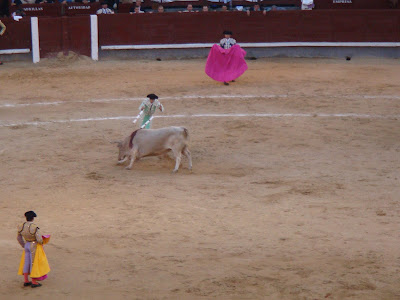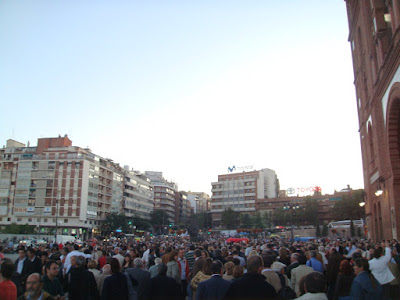Location: Madrid
I was really torn about going to a bullfight here. I don't have a particular interest in seeing animals tortured and killed for sport, and even less when I have to pay for it. I in no way endorse animal violence. But as uncomfortable as it makes me, I've learned that other countries, people, and cultures do things differently. And since I came to Spain to fully experience its culture, I did wind up going to a show.
Many of the locals tell me that bullfighting is actually a dying sport here. The younger generations are not taking much interest and other sports like Futbol and Basketball (you may remember Spain took the silver medal in Basketball this past Olympics) are gaining popularity.
The ticket prices here range by a surprising amount (anywhere from 3 to 100 euros) depending on the proximity to the front and if the seat lies in the sun or shade. I sat in the sun and almost all the way in the back (the really cheap seats), and my ticket was 7 euros.
Madrid has the largest bullring in Spain and one of the largest in the world. With a capacity of ~25,000, Las Ventas is a remarkable sight to see. It reminded me of the Coliseum recreation in the movie Gladiator - essentially a large circular stadium with an open middle and nothing but sand on the ground.
Here is a good shot of the empty stadium, courtesy of Wikipedia.
 Of course the Spanish love their drinks, so anything can be ordered from the many fully-stocked concession bars. I found this curiously different that how it's done in the States.
Of course the Spanish love their drinks, so anything can be ordered from the many fully-stocked concession bars. I found this curiously different that how it's done in the States. And here's what it looked like on the Sunday I was there.
And here's what it looked like on the Sunday I was there.
One additional interesting thing to mention is the bullfighting season was currently nearing its end here, but it's near peak season in Mexico. This means all the top matadors are there for several months, leaving only the young matadors who are still in training here in Madrid. Someone pointed out these shows are often more exciting exactly for the fact that they aren't as experienced...one sees more errors and thus appreciates how difficult it is. Makes sense to me - I saw two separate news reports the week before I went about a matador getting gored at the stadium.
HOW A SPANISH BULLFIGHT WORKS
A Madrid bullfight consists of six bulls & three matadors with each matador being accompanied by his assistants. In a little over two hours the matadors will each kill two bulls, totaling 6 in the whole show.
The spectacle starts with matadors and their assistants entering the bullring and parading in front of the crowd. The front matador is usually the most experienced or kind of a "distinguished guest". Everyone then goes to their respective areas behind the outer ring and awaits the first bull. A horn sounds and it's released.
At first only the assistants are in the ring, and the bull comes out charging fast. It runs mostly from end-to-end as the assistants either dodge or move behind a small structure for safety. The reasons for this are several: it starts to tire the bull, and it gives the matador a chance to see how it behaves.
Here's a picture of it. The assistants all had fuchsia capes.
 And another pic with an assistant which turned out really well. I can only imagine the courage it takes to stand your ground as this huge deadly animal is running the entire length of the ring directly at you.
And another pic with an assistant which turned out really well. I can only imagine the courage it takes to stand your ground as this huge deadly animal is running the entire length of the ring directly at you. And here's a pretty good video of it too.
And here's a pretty good video of it too.This is what it looks like when the bull attacks a rider and is lanced.
 After another signal from the band, the riders leave and the assistants return. However, two of them are now each carrying two small sharp staffs called "banderillas". Their job is to get the bull to charge, dodge at the last second and plant the staffs into the bull's shoulders. Many of the assistants we had were unable to do this correctly, and I admit it looked quite difficult.
After another signal from the band, the riders leave and the assistants return. However, two of them are now each carrying two small sharp staffs called "banderillas". Their job is to get the bull to charge, dodge at the last second and plant the staffs into the bull's shoulders. Many of the assistants we had were unable to do this correctly, and I admit it looked quite difficult. Here's a video of both assistants seeming to get it right. Notice how the staffs dangle and stay in the bull if done correctly.
Here's a video of both assistants seeming to get it right. Notice how the staffs dangle and stay in the bull if done correctly.This part of the process also ends with a signal from the band, and now the matador (which literally translates to "the killer") enters. At this point it's just him and the bull, and he starts by acknowledging the crowd and then proceeds to use his red cape to have the bull charge him.
 A good matador is supposed to hold his ground with a totally rigid body and lead the bull from side to side without moving or having the cape leave the ground. This must be quite difficult because none of the three we had even came close to pulling all these conditions off.
A good matador is supposed to hold his ground with a totally rigid body and lead the bull from side to side without moving or having the cape leave the ground. This must be quite difficult because none of the three we had even came close to pulling all these conditions off.Notice how this bull is light-colored compared to the traditional black ones. It was fascinating because it became apparent just how much the bulls were bleeding by this point. Notice all the color around it's neck...
 Eventually the bull tires from exhaustion and blood loss, and the matador walks to the side and takes a sword from an assistant. This is a great picture which shows what it looks like.
Eventually the bull tires from exhaustion and blood loss, and the matador walks to the side and takes a sword from an assistant. This is a great picture which shows what it looks like. And a video of the matador controlling the bull.
And a video of the matador controlling the bull.Finally, he then temps the bull to charge a few more times, then eventually makes a pose where he points the sword directly at the bull, which signals at the next charge he will attempt the death blow. If done correctly he will strike directly between the shoulder blades and into the heart. If he misses the bull is still often immobilized and quite injured, and then an assistant will come and deliver the final blow with a dagger between the eyes.
 After this the crowd will cheer based upon their satisfaction of the matador to both control the bull and to deliver a quick and respectful death. Depending on the level of cheering the matador may be awarded either: 1. nothing, 2. one ear, 3. both ears, or 4. both ears and the tail. I don't know what the matadors were awarded during my show.
After this the crowd will cheer based upon their satisfaction of the matador to both control the bull and to deliver a quick and respectful death. Depending on the level of cheering the matador may be awarded either: 1. nothing, 2. one ear, 3. both ears, or 4. both ears and the tail. I don't know what the matadors were awarded during my show.The bull's body is then dragged away where the meat is sold in high-end restaurants, and then the next bull comes out and the process starts over again.
 And a video of the spectacle. This was really a sobering moment for me when it left a trail of blood in the sand.
And a video of the spectacle. This was really a sobering moment for me when it left a trail of blood in the sand.Of course things don't always go as planned. Here is one of the assistants having to run out of the arena after messing up the placement of his banderillas.
 And a video of a similar experience.
And a video of a similar experience.And although no one was gored during my show, it does happen with some regularity and here's what it can look like.
 And this one is one of the most famous and experienced matadors from earlier this summer.
And this one is one of the most famous and experienced matadors from earlier this summer. Here's a video I took of one matador attempting a deathblow which goes awry. Try to focus and follow his sword.
Here's a video I took of one matador attempting a deathblow which goes awry. Try to focus and follow his sword.This is a great shot of the stadium right after sunset but still during the show.
 Afterwards, all 25,000 of us are leaving together and trying to get into the same one metro stop. Fun stuff.
Afterwards, all 25,000 of us are leaving together and trying to get into the same one metro stop. Fun stuff. In hindsight I found it to be a very interesting experience, although not one I would likely seek out again. I've never seen anything like it, so I'm glad to have gone in the sense that I gained a small insight into the culture here.
In hindsight I found it to be a very interesting experience, although not one I would likely seek out again. I've never seen anything like it, so I'm glad to have gone in the sense that I gained a small insight into the culture here.
No comments:
Post a Comment